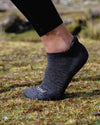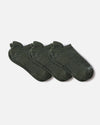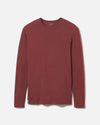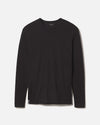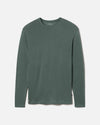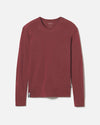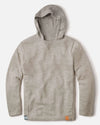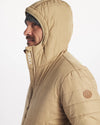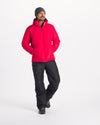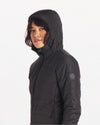

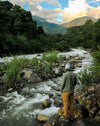

Hiking allows you to disconnect from the chaos of daily life and immerse yourself in the beauty of nature. As you embark on a hiking adventure, your attire becomes more than just clothing – it becomes your armor against the elements, your support system for comfort, and your ultimate companion that’s with you no matter what your journey brings. So, whether you're an experienced hiker or a novice eager to explore the trails, understanding what to wear while hiking is crucial for an enjoyable and successful expedition. In this guide, we'll delve into the essentials of trail attire.
Equipping yourself with the right hiking attire is essential for a successful and enjoyable outdoor adventure.




Equipping yourself with the right hiking attire is essential for a successful and enjoyable outdoor adventure.


Comfort Is Key
Imagine trudging along uneven terrains, ascending steep inclines, and navigating rocky paths in ill-fitting or uncomfortable clothing. The discomfort caused by poorly chosen gear can quickly overshadow the beauty of your surroundings, and distract you from being immersed in nature. Properly selected hiking clothing, on the other hand, can provide the freedom to move, breathe, and explore without any interruption, making sure you stay present on the trail.
Protection Against the Elements
Pachamama (Mother Nature) is a powerful force, and she can be unpredictable. Hiking attire serves as your shield against the elements, whether it's the scorching sun, biting cold, or sudden rain showers. Appropriate clothing can protect you from sunburn, wind chill, and even hypothermia. A cap shields your face from harmful UV rays, moisture-wicking fabrics keep you dry, and waterproof layers keep you comfortable in wet conditions. Being prepared for varying weather conditions enhances your safety and ensures that this uninterrupted connection with nature is maintained.
Functionality and Mobility
The trails often present unforeseen challenges. Whether it's a sudden stream crossing or a steep rocky ascent, your attire should support and not hinder your progress. Hiking attire designed with functionality in mind ensures that you can maneuver through obstacles, tackle steep ascents, and embrace the beauty of your surroundings without feeling restricted. Well-designed hiking pants, shirts, and jackets provide ample freedom of movement.




Moisture Management
As you push your physical boundaries, sweat is a natural outcome. Materials that wick away moisture can spell the difference between a comfortable hike and a soggy ordeal. Moisture-wicking fabrics pull sweat away from your skin, allowing it to evaporate quickly ensuring you stay dry and comfortable throughout your hike. This prevents the accumulation of moisture, which can lead to chafing, blisters, and an overall unpleasant experience.
Prevention of Chafing and Blisters
Prolonged hiking can lead to friction-based discomforts, including chafing and blisters. The right attire can significantly reduce the risk of these issues. Moisture-wicking fabrics and seamless construction minimize friction, reducing the likelihood of chafing. While properly fitted footwear and socks helps prevent blisters, allowing you to focus on the trail.
Layering for Temperature Control
With temperature swings common during hikes, mastering the art of layering is key. Being able to shed or add layers ensures you remain in the comfort zone, regardless of changing weather. Proper layering involves a moisture-wicking base layer, an insulating mid-layer, and a waterproof outer layer. This system enables you to regulate your body temperature by adding or removing layers as needed, ensuring optimal comfort.




The Best Types Of Fabrics For Hiking
When determining what fabrics to use for your layering system, you’ll need to take into account the properties and impact of the fabric. Here’s what makes alpaca the ideal choice.
1. Soft and Comfortable:
Alpaca fiber is a natural material derived from the fleece of alpacas, camelid animals native to the Andes Mountains. It stands out due its incredible softness, lightweight feel, and exceptional insulating properties. Unlike traditional wool, alpaca fiber is not prickly and doesn't cause itching, making it an ideal choice for those with sensitive skin.
2. Superior Thermal Regulation:
One of the standout features of alpaca fiber clothing is its remarkable ability to regulate body temperature. Alpaca wool is naturally insulating, keeping you warm in chilly conditions, while its breathable nature prevents overheating during strenuous hikes. This thermal regulation is crucial for maintaining comfort and preventing moisture buildup, especially during long hikes with varying weather conditions.
3. Moisture Management:
Alpaca fiber has inherent moisture-wicking properties (only 8% absorbent, compared to 16-20% in other wools), pulling sweat away from your skin and allowing it to evaporate quickly. This moisture management feature is essential for keeping you dry and comfortable, minimizing the risk of chafing and discomfort during extended hikes. Unlike synthetic materials, alpaca fiber doesn't retain odors, making it an excellent choice for multi-day hiking trips.
4. Lightweight and Packable:
Due to its hollow air pockets, alpaca fiber is remarkably lightweight (3x lighter than sheep's wool), allowing you to layer up without feeling weighed down. It’s also highly compressible, making it easy to pack into your backpack while saving valuable space for other essentials.
5. Natural Odor-Resistance:
Alpaca fiber contains keratins that make it naturally resistant to odors. This is a significant advantage for hikers who are out on the trails for extended periods without access to frequent laundry facilities. Feeling confident and fresh even after days of active hiking is a major perk of alpaca fiber. Merino is a great option too.
6. Durability and Longevity:
Hiking in alpaca fiber is not just about immediate comfort – it's also a long-term investment. Alpaca fiber is known for its durability and resilience, meaning your hiking gear will stand the test of time and countless outdoor adventures. Proper care will ensure that your alpaca fiber clothing remains in top condition, providing you with reliable performance for years to come.
7. Environmentally Friendly:
For eco-conscious hikers, alpaca fiber clothing offers another compelling advantage. Alpacas have a remarkably low environmental impact especially compared to other livestock, and their wool is biodegradable. Choosing alpaca fiber clothing supports sustainable practices and reduces your carbon footprint while enjoying the great outdoors.



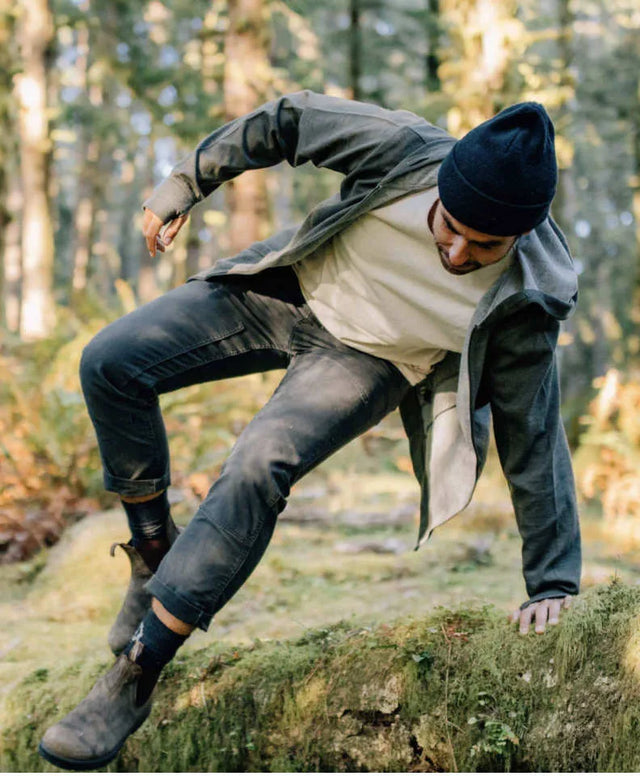
What To Wear Hiking: Hiking Clothing & Gear Checklist
1. Start with the Right Base Layer:
The ideal ensemble begins with a moisture-wicking base layer. This foundational piece is like a second skin, keeping you dry and comfortable throughout your trek. Opt for fabrics like alpaca that efficiently wick away sweat, preventing discomfort and chafing. Even in warmer weather, moisture control is vital for preventing hypothermia, as damp clothing can lead to rapid heat loss. Choose a well-fitting base layer that allows for easy movement and provides a comfortable barrier between your skin and outer layers.
2. Choose a Breathable Shirt:
Selecting the right shirt is a crucial step in crafting your hiking outfit, and you have a range of options to consider. For sun protection and insect resistance, long-sleeved shirts are a smart choice. Look for those with UV protection and breathable materials that allow air circulation. In warmer conditions, opt for short-sleeved shirts with quick-drying properties. Versatility is key – choose a shirt that can adapt to changing weather conditions and provide comfort throughout your hike.
3. Prioritize Functional Bottoms:
Your choice of pants or shorts can greatly impact your mobility and comfort on the trail. Consider the terrain and weather conditions when making your decision. For rugged trails or cooler temperatures, hiking pants offer protection against abrasions and unpredictable weather. If you're hiking in warmer climates, you can also opt for lightweight, moisture-wicking hiking shorts that allow for unrestricted movement. Even in warmer weather, depending on the terrain, pants may still be the preferable choice for greater protection.
4. Step into Supportive Footwear:
Hiking footwear is perhaps the most critical aspect of your hiking attire. Ill-fitting or inadequate shoes can lead to discomfort, blisters, and even injuries. Invest in a pair of high-quality hiking boots or trail shoes that offer proper arch support, cushioning, and ankle stability. Ensure you break in your footwear before embarking on a long hike to prevent painful blisters. Trail runners can be a suitable option for well-maintained trails or shorter hikes, but for more challenging terrain, sturdy hiking boots are the way to go.
5. Don't Skimp on Socks:
Socks significantly impact your comfort on the trail. Opt for moisture-wicking, cushioned socks that provide ample padding and reduce friction, thus minimizing the risk of blisters. Look for socks with reinforced heel and toe areas for added durability. Alpaca socks offer the added benefit of odor resistance so you can enjoy the end of the hike when your shoes come off as well.
6. Prepare for Rain and Wind:
Nature has a way of surprising us, and that includes sudden rain showers or unexpected gusts of wind. Pack a lightweight, waterproof jacket or poncho that can be easily stowed in your backpack. Look for options with ventilation features to prevent overheating during exertion. Waterproof pants can also be a valuable addition to your hiking gear, providing full protection in wet conditions.




What To Wear Hiking Based On The Season
As the seasons change, so do the landscapes, weather conditions, and challenges that await you on the hiking trails. From the vibrant blooms of spring, to the sun-soaked adventures of summer, the crisp air of autumn, and the snowy wonderland of winter, dressing appropriately allows you to fully immerse yourself in nature's splendor. So, gear up, layer wisely, and embark on your seasonal hiking adventures with confidence, knowing that you're well-prepared to embrace the great outdoors, no matter what the weather brings.
Spring:
Spring hiking offers a mix of crisp mornings and warmer afternoons. Start with a moisture-wicking base layer to keep sweat at bay and prevent chafing. A lightweight, breathable long-sleeved shirt offers protection against cool breezes and potential sunburn. Convertible pants are an excellent choice, allowing you to adapt to changing temperatures throughout the day. Consider packing a lightweight, packable rain jacket to stay dry during unpredictable spring showers.
Summer:
Summer hiking calls for lightweight and breathable clothing. Moisture-wicking t-shirts or tank tops tank tops are a great choice to stay cool and comfortable. Also consider lightweight longsleeves with UPF sun protection. Choose hiking shorts that provide freedom of movement and ventilation or pants depending on the terrain. Opt for moisture-wicking underwear to minimize chafing.
Autumn:
Autumn's changing colors create a stunning backdrop for your hikes, but the weather can be extra variable. Start with a moisture-wicking base layer, but feel free to add a lightweight mid-layer like an alpaca sweater or a softshell jacket as the temperatures drop. Hiking pants provide protection against chilly winds and potential rain. Pack a waterproof and wind-resistant outer layer to stay comfortable in case of sudden weather changes. A beanie is a great accessories to keep you warm during cooler autumn hikes.
Winter:
Winter hiking demands some extra preparation, especially for safety. Begin with a moisture-wicking base layer and add an insulating mid-layer like a thermal fleece. Choose hiking pants that provide insulation and wind protection. A waterproof and insulated jacket is essential to shield you from snow and rain. Invest in high-quality, insulated and waterproof hiking boots to keep your feet warm and dry. Don't forget thick, moisture-wicking socks for added comfort. A beanie, gloves, and a neck gaiter offer extra warmth for your extremities.




Final Thoughts & Gear Mentioned
Equipping yourself with the right hiking attire is essential for a successful and enjoyable outdoor adventure. As you layer up thoughtfully, and prepare to embark on your hike, remember, your hiking attire is more than just clothing – it's your ticket to embracing the wonders of the outdoors with care-free comfort. So, whether you're going for a short hike before work, or heading out for a multi-day hike, you can travel with ease knowing you’ve got the right gear no matter what Pachamama throws your way.

Join the herd.
We grant our community private access to new products and exclusive offers.




















